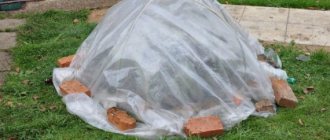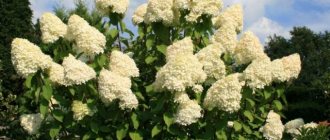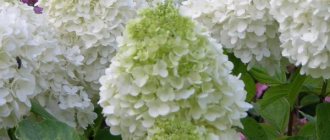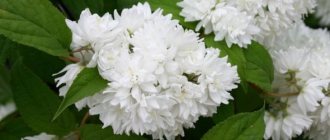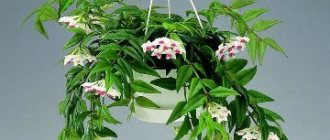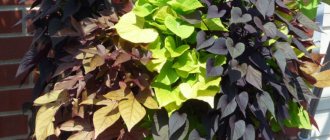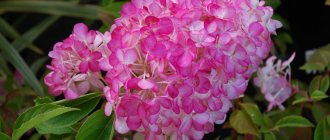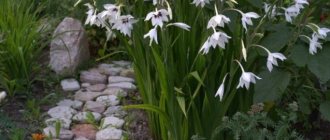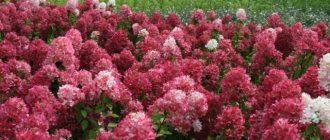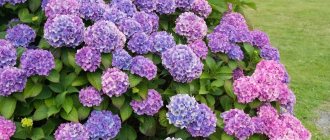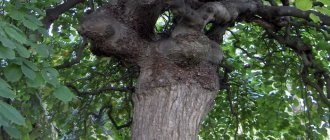Types and varieties of indoor hydrangea
Hydrangea is a plant whose height reaches one and a half meters. Belongs to the type of subshrubs. Has spreading leaves. They have small notches along the very edge. It is distinguished by very large inflorescences that reach up to 30 cm in length.
Varieties have been bred to create a large palette of colors. Let's look at the most common ones for home floriculture.
- Tree-like. A shrub whose height reaches 3 meters. The leaves are large and fleshy. Bright green hue. The flowers form a spherical sphere and reach a diameter of 25 cm. Flowers are most often colored milky or beige. One of the most unpretentious varieties.
- Large-leaved. The length reaches 2 meters. Suitable for both home growing and greenhouse growing. The leaves are quite large. The shoots are always light green. The variety is resistant to cold, so even in the winter season it feels great on a cold window.
- Paniculata. Looks like a large spreading shrub or small tree. The height reaches 6 meters. The leaves have an elongated shape. And the shoots turn brown with age. The plant is resistant to cold. The inflorescences gradually form a small pyramid. They have shades from milky to blue. By autumn, the flowers acquire a reddish or even brown tint.
Flowers also differ in the color that is inherent in them during flowering. There are varieties:
- red sensation;
- Early Blue;
- Europe;
- star;
- linear and so on.
However, the color of the inflorescences is affected not only by the variety, but also by the composition of the soil. For example, if it is sour, then a blue tint appears in the flowers. If it is more alkaline, then the pigment is pink or red. If the soil is neutral, then you will get boiling white flowers with milky splashes.
Features of home hydrangea
Hydrangea domestica is a perennial shrub. Its large, opposite leaf blades are ovoid in shape and have a serrated edge. Their length is 10–15 centimeters. Quite large spherical inflorescences can reach about 35 centimeters in diameter. They have the shape of a shield, an umbrella or a brush, and they contain two types of flowers: small fertile ones are located in the center, and larger sterile ones are located at the edges. The uniqueness of this plant is that the color of its inflorescences is directly dependent on the pH of the soil on which the bush grows:
- acidic soil - bluish color;
- neutral - cream or white;
- alkaline - pink or lilac.
At the same time, all the petals of the flowers are colorless, but their sepals have a rich color, which makes the inflorescences decorative. The fruit is a multi-seeded capsule. When grown indoors, the height of the bush can reach up to 100 cm.
Indoor hydrangea care at home
How to choose hydrangea in a store
It is believed that it is better to purchase flowers in specialized stores.
The first thing to do is look at the stem. It should be dense, elastic, and have an expensive green color. There should be no brown or yellow growths on the leaves. They should be juicy and bright green. If the hydrangea leaves are limp, dry at the edges, or have white or yellow spots on them, you should refuse to purchase.
Carefully examine the hat of flowers. It should be dense, rich, bright colors. If the cap is pale, and the flowers begin to fall when touched lightly, it means that the plants did not receive enough nutrients.
There is one general rule that should be applied to choosing a flower - it should look healthy, nourished and moisturized.
Types of home hydrangea with photos
Only large-leaved hydrangea (Hydrangea macrophylla), which is also called garden hydrangea, is grown indoors. And also many of its varieties are used for this (more than a hundred).
Varieties with cream and white inflorescences:
- M-me E. Mouillere . The inflorescences reach from 18 to 20 centimeters in diameter, and the flowers are 20–60 mm. This plant differs from other varieties in its narrower foliage.
- Souer Tharese . An early-flowering low-growing bush reaches a height of 35 to 40 centimeters. The inflorescences consist of flowers of regular shape, and in diameter they reach from 15 to 17 centimeters.
Varieties with pink inflorescences:
- Goliath . The late-flowering plant reaches a height of 0.6 to 0.7 m. Rich pink large inflorescences reach about 30 centimeters in diameter. The edge of the sepals is deeply cut.
- Hamburg . The plant has a height of 0.35–0.4 m. The diameter of the inflorescences reaches 16–18 centimeters, and they consist of pink flowers with a diameter of 40–50 mm.
- Europe . The height of the luxuriantly flowering bush is 0.4–0.5 m. The diameter of the inflorescences is 20–25 centimeters, and the diameter of the flowers is about 60 millimeters.
Varieties with red inflorescences:
- Red sensation . Inflorescences are reddish-burgundy. If you add iron salts to the substrate, then they will turn burgundy-violet.
- Prima . This plant belongs to the medium-flowering varieties, and its height is from 20 to 25 centimeters. Small flowers in diameter, reaching 35 mm, are collected in small inflorescences (15–18 centimeters in diameter).
Varieties with blue inflorescences:
- Early Blue . This vigorous plant is decorated with deep blue inflorescences.
- Ramars Mars . The compact bush has inflorescences up to 20 centimeters in diameter. Gradually, the edges of the petals turn greenish.
Types and varieties of Hydrangeas. Which Hydrangeas are best to grow at home?
Care and replanting after purchase
It is not recommended to replant hydrangea immediately after purchase. The plant must get used to new conditions. Give her 2 weeks to 1 month to adapt.
In the future, the transplant procedure should be carried out at least once every 3–4 years.
If you ensure annual replanting into larger pots, you can ensure the fullest blooms your hydrangea can produce. The roots of the plant grow in width, so the volume of the pot must match.
Choose a pot that is slightly larger than the diameter of the one you purchased the flower in.
While the plant adapts, you can gradually acquire components for the substrate. You will need 1 part sand, two parts peat, two parts deciduous soil and 4 parts turf soil. All this is mixed and poured into the pot.
Do not forget that during the first stages of life in a new room, hydrangeas will require additional care in the form of fertilizing. It is better to buy mineral fertilizer intended specifically for indoor flowering plants. You can buy it in a specialized store. It is important not to overdo it, so dilute the fertilizer according to the instructions and water the flower in the amount indicated on the package.
Hydrangea does not like direct sunlight, but loves warmth and diffused light. Therefore, it is better to place it on a shaded window.
As soon as the hydrangea gets stronger, you can take care of it and replant it.
At first after purchase, namely, the first two weeks, it is better not to overwater the plant. It is necessary to moisten the soil as it dries. But spraying leaves and flowers from a spray bottle is highly recommended. This procedure must be performed once every two days.
Inimitable flowering of indoor hydrangeas
Indoor hydrangeas bloom at a different time than their garden counterparts. Unlike garden beauties that love midsummer, indoor large-leaved hydrangeas begin their parade in February-March and complete their flowering by July. Plants can be forced, so flowering hydrangeas can be found on sale at other times. By changing the dormant period, you can regulate their flowering at home.
The shape of inflorescences in indoor hydrangeas can differ significantly even within the same species. There are varieties with inflorescences resembling perfect balls, there are hydrangeas with flat caps, and there are also those with multi-level shields. They differ in the density of the flowers and the size of the inflorescences - from 5 cm in miniature varieties to more than 20 cm in classic beauties.
In inflorescences, large sterile flowers are located at the edges, as if closing over the fruit-bearing ones, but in varietal plants the shields seem solid and the difference is not noticeable.
The actual flowers of hydrangeas are inconspicuous. They are miniature, looking like a small bead against the background of much brighter, flat and brightly colored bracts that look like diamond-shaped petals. Hydrangea flowers, with their four petals, appear almost papery.
The color palette of indoor hydrangeas is somewhat expanded compared to large-leaved garden hydrangeas. The thing is that flower centers use different tactics to enhance and change color with artificial treatments that cause pigmentation. Thanks to them, a bush on the counter can surprise with its bright blue, light green and even yellow color. But such unnatural beauties will not be able to please you for long and are unlikely to last next year.
The natural range of indoor hydrangeas includes white, pink, purple and blue spectrums in the softest, pastel variations.
Hydrangea macrophylla 'Early Blue'.
Caring for hydrangea at home
Lighting for indoor hydrangea
If you choose the right lighting for a flower, it will delight you with its color for a long time.
It is important to choose the right place here. This is necessary so that there is an abundance of color. However, the leaves and flowers of the plant should not be exposed to direct sunlight. Therefore, you need to place the flower at a distance of approximately 3–4 m from the window. In this case, the plant will feel ideal.
Temperature for hydrangea
In terms of temperature, the plant is capricious. The ideal room temperature is between 18 and 23 °C. It is ideal for hydrangeas. The plant should not be exposed to drafts, as it may die.
In winter, this flower can be placed in a room where the temperature is 10 °C. Then the hydrangea will go into a short hibernation and accumulate strength until the new summer season.
Don't forget about watering. The water used to irrigate the land must be at room temperature. Under no circumstances should you use water from the refrigerator.
Watering hydrangea
Caring for hydrangeas in terms of watering should include regularity.
- Hydrangea loves fresh water very much. It can be classified as a moisture-loving plant.
- For irrigation, settled water that is at room temperature is ideal.
- The hotter it is outside the window, the more often you need to irrigate the soil. Don't forget to spray the flowers and leaves with a spray bottle. However, you should not be overzealous with watering. It needs to be renewed as the soil dries out. If you overwater it, the hydrangea can easily rot.
- If the hydrangea leaves begin to turn yellow, this means that it lacks acid. Therefore, sometimes you need to give her a shower with acidic water. To do this, mix 5–8 drops of lemon juice in one liter of water.
Air humidity
Hydrangea loves humidity in the air. Therefore, when the heating season begins and the air is dry, the plant suffers greatly. Therefore, do not forget to spray it with a spray bottle.
If you have a humidifier, place the plant pot nearby. It is enough for hydrangea to spend about half an hour next to a humidifier to stock up on moisture for several days ahead.
Brief description of cultivation
- Bloom . It starts in April and ends in November.
- Illumination . The light should be bright, but at the same time diffused. To do this, it is enough to place the bush near a south-facing window (at a distance of 200–300 cm).
- Temperature regime . During the growing season - about 20 degrees, and during the dormant period - from 7 to 10 degrees.
- Watering . During the summer months, the bushes need plenty of frequent watering. In spring and autumn, water more rarely and moderately. During the dormant period, the soil is moistened rarely and sparingly.
- Humidity . Requires high air humidity. On hot days, the bush should be moistened as often as possible with a spray bottle.
- Fertilizer . Feeding is carried out during the period February–October. To do this, use a mineral complex for flowering plants (heathers, azaleas and rhododendrons), and apply fertilizer to the soil twice a month. In winter, the plant does not need fertilizer.
- Rest period . Observed in December and January.
- Transplant . It is carried out only for indoor hydrangea every year, and its life expectancy is from 3 to 4 years.
- Trimming . In the autumn, when the bushes have faded, weakened stems must be cut off, and powerful shoots must be shortened by ½ part of the length. With the onset of spring, cut out any weak stems that have become very elongated during the dormant period.
- Reproduction . By cuttings, dividing the bush and seed method.
- Pests . Spider mites and aphids.
- Diseases . Downy mildew and gray mold.
Feeding
In the spring and summer, Hydrangea enters the active stage. At this stage, for enhanced growth, she will need additional amounts of useful minerals and organic substances. Therefore, it is at this stage that it is worth using organic fertilizer.
Unfortunately, if you neglect such care, the plant will stop blooming and develop further.
When watering several times a week, you need to add a few drops of potassium permanganate to the water.
Winter care does not involve the use of fertilizing.
Gardeners say that gibberellin solution is successful in caring for hydrangeas. Approximately 0.1 g per 1 liter of water is used. Thanks to the composition, hydrangea quickly enters the flowering state.
How to care for planted hydrangea?
Before planting in the ground, you can prune and shape the bush. It is advisable to remove branches that are broken, weathered or have not survived the winter as soon as the buds begin to swell.
Among the gardener's current problems are late frosts after a relatively warm period. Until mid-May, you should monitor the weather reports, and in case of cold weather, cover the planted bushes with spudbond. This can be done in the same way as coniferous shelter is made:
- install a frame made of wire or wooden slats near the bush;
- pull covering material over it;
- in case of severe frost (below -5°C), additionally cover the large-leaved hydrangea with burlap or cardboard.
If a successfully overwintered hydrangea can be protected from spring freezing, it will begin to bloom at the end of May.
Trimming
The pruning procedure is mandatory in order to maintain the attractive appearance of the plant. For this procedure you will need a well-sharpened knife or pruning shears. The cut should be sharp and even.
During pruning, weak leaves and stems that have begun to dry out or rot are removed. It is also necessary to trim the top of the plant in order to form a more luxuriant crown.
It is ideal to prune twice a year. This is in the fall, when the flowering period has passed, you need to remove weakened leaves and in the spring, when you need to remove weakened shoots.
During the flowering period, the pruning procedure stops. It begins when the first faded flowers or leaves appear. They are the ones that need to be removed so that the plants do not rot.
Pruning and shaping hydrangeas
The rapid growth rate often comes as a surprise to those who buy indoor hydrangeas without studying their characteristics. These shrubs develop and grow at an amazing rate, even on windowsills. But pruning is necessary for hydrangeas not for compactness, but for flowering - without it, these beauties will not bloom.
Indoor hydrangeas should be pruned immediately after flowering has finished. If pruned late, hydrangeas will bloom much less, or may not bloom at all. Standard pruning is carried out at 1/3 of the height of the branches. If hydrangeas stretch out in the spring, young branches grow too quickly, they are shortened again to contain them and make them compact.
Sanitary “cleaning” of hydrangeas should be carried out regularly. Removing dry leaves, damaged parts, weak shoots, and cutting off inflorescences as they wilt are necessary not only to maintain a neat appearance, but also to maintain health and reduce the risk of damage to the bushes.
All indoor hydrangeas, as a rule, have much more stable shoots and do not fall apart under the weight of the inflorescences. But if there are signs of sagging branches and poor stability, it is better to tie the bushes to a support.
Hydrangeas are one of the indoor plants that are extremely sensitive to soil reaction and its quality.
Rest period
The dormant period of hydrangea begins in the cold season. As a rule, during autumn frosts. Plants go dormant, begin to consume less moisture and stop blooming. To allow the plant to gain strength before the next season, it must be placed in a room with a temperature of no more than 10 degrees. Do not forget about watering as the soil dries out.
Hydrangea will resume its vitality in late March - early April, when the sun begins to actively warm up.
How to store in a pot until spring
There is nothing difficult about preserving hydrangea until spring.
To do this you need to follow a simple scheme:
- in the fall, complete all the preparatory steps: gradually reduce watering, stop fertilizing, trim the plant and replant it in a new pot;
- create optimal conditions for wintering: store the pot in a cool, dry and dark place.
Many gardeners have learned from their own experience that growing homemade hydrangea is not at all difficult. It is important to understand how much winter dormancy is necessary for the plant. With a caring and attentive owner, the grateful plant will bloom until late autumn.
Reproduction
Hydrangea can be propagated in various ways. Some are more, some are less effective. Let's look at the nuances of each method.
Propagation by cuttings
Propagation by cuttings is the easiest way. The most favorable time for this is January or February.
Take a closer look at the root shoots. Cut the cuttings so that there are no more than three nodes on the branch. Their length should be approximately 8 cm. All leaves should be removed from the bottom of the cut root. The upper leaves should be shortened exactly by half.
The cut on the lower side must be treated with a special root stimulator, which is sold in specialized stores.
The cuttings must be planted in a specially prepared substrate, which consists of peat and sand. Provide maximum humidity, which will promote rapid root formation. Ideal temperature is up to 20 degrees.
Some housewives advise covering the cuttings with special glass jars. However, once a day you need to leave the plant to air for several hours, removing the glass protection. The plant needs constant moisture, so the soil needs to be watered and the leaves should be sprayed with a spray bottle.
After just one month, the cuttings can be planted on prepared peas.
Reproduction by dividing the bush
Dividing the bush is another common method. However, you need to act with caution so as not to spoil the entire bush.
The shoots are evenly shortened. The bush is divided into several parts, carefully freeing the roots. Parts of the plant need to be distributed into different pots into a specially prepared adversary and watered.
You can apply a mulching procedure, which is designed to root the plants faster. It is better to carry out this procedure in the spring so that by autumn the plant feels comfortable in the pot.
Propagation by seeds
When growing seeds, the procedure must be carried out already in February.
- Prepare the soil, which consists of turf and humus.
- Additionally, admixtures of peat or sand can be added to it.
- Purchase special containers that are designed for growing.
- Scatter hydrangea seeds on top. They do not need to be buried in the ground.
- Water the soil well.
- Then you need to cover the container with cling film or glass. Every day you need to ventilate the crops and moisten them with a spray bottle. Remember to keep the soil mostly moist, but not wet.
- As soon as the first shoots appear, the cling film can be removed.
When two leaves appear, they need to be picked in a container.
Reproduction by layering
This type of propagation is best done in March. Used for plants that grow in open ground. However, it can also be used for home flowers.
- The soil around is dug up and compared.
- Small grooves are made to a depth of 2 cm. Approximately one shoot is placed in them. By the way, the shoots need to be cut off from the bottom of the bush.
- They are laid parallel to the ground and covered with earth.
- Then you need to constantly spray the area with a spray bottle to achieve adequate moisture.
- As soon as the roots appear, you need to make a constriction of soft wire. It is carried out in three turns.
- The more the wire is pressed, the faster roots will appear from this place.
By the end of summer, several months after the start of reproduction, several young shoots appear on the cuttings. Once they reach a height of 20 cm, they can be transplanted into a separate pot.
Transplantation, containers and substrate
Unlike many indoor plants, hydrangeas should not be replanted in early spring, at the beginning of growth. The best time to replant these beauties is after flowering and pruning. If you postpone replanting until February-March, the most important period for preparing flowering, the hydrangea will have to face new conditions and begin to adapt, which is why it may not bloom at all.
But for hydrangeas it is better to violate the requirement to replant after the plant fills the old pot with roots. They are replanted annually, grown in fairly compact containers that allow them to develop throughout the year. Hydrangeas prefer wide and shallow pots.
Hydrangeas are one of the indoor plants that are extremely sensitive to soil reaction and its quality. Even the slightest differences from the preferred pH values or unusual deviations in the new substrate are manifested primarily in the colors of the plant: hydrangeas bloom differently in different conditions.
To fully appreciate the characteristics of the variety and the color scheme of the plant, you should grow hydrangeas only in a special substrate for rhododendrons. This especially applies to hydrangeas with a cold palette of colors - blue, purple, blue-violet shades. Any hydrangeas feel uncomfortable in soil whose pH values go beyond 4-5.
Hydrangeas are handled very carefully, without contacting the roots and without destroying the earthen coma. After planting hydrangeas, water them abundantly. It is better to keep the plant in high air humidity, very “mild” temperatures and lighting until growth resumes and adaptation is completed. Drainage at the bottom of the container is required.
Indoor hydrangeas prefer mulching the substrate - both clean peat and decorative mulch (which does not interfere with air access to the roots) are suitable.
Diseases and pests
Hydrangea is prone to diseases, which form on it with surprising frequency.
- Gray rot. Appears on the leaves if you overdo it with moisture. Reduce watering and make it a rule to treat the flower with a special Bordeaux mixture.
- Spider mite. When the air is dry, on the contrary, spider mites or aphids appear on the plant. To destroy this scourge, you need to water the hydrangea with a soap solution or a special product from the store.
- Downy mildew. Appears at high humidity. Eliminated through the use of drugs that contain copper.
- Nematode. A nightmare for hydrangeas. If the plant is affected by more than 50%, then, unfortunately, it cannot be saved and will have to be thrown out.
Hydrangea propagation
Indoor hydrangea bushes are rarely propagated, most often preferring to use garden plants as “material”. Meanwhile, only special indoor varieties retain compactness, branchiness and are much better adapted to being kept outside the open air. If possible, it is better to propagate indoor hydrangeas initially.
The only propagation method used for indoor hydrangeas is cuttings. To do this, use apical cuttings from young branches that actively grow in the spring. Green cuttings root better than semi-lignified ones.
You can start cutting hydrangeas from January-February; April is considered the deadline. For indoor hydrangeas, the standard is considered to be a cutting with a length of 8 to 10 cm. Rooting is carried out in a peat-sand substrate, with constant soil moisture and under a hood. Plants are planted in individual containers.
The division of bushes, as well as the separation of offspring on indoor bushes, is permissible, but only parts with at least 3-4 shoots can be separated. Plants do not tolerate contact with their roots well and then take a long time to adapt.
Garden bushes can also be propagated by layering to produce offspring that could be used in rooms.
Hydrangeas are very rarely grown from seeds. Sowing is carried out superficially, under the film, with thinning and diving at the stage of the third leaf into individual containers.
Preparing for winter
Before sending the hydrangea into hibernation, it must be prepared on the eve of the onset of cold weather.
The plant cannot overwinter in Russian winter conditions without appropriate insulation. This also applies to indoor hydrangeas. You should not place hydrangea on an open balcony where the temperature is below 0 degrees. The ideal temperature for wintering hydrangea is +10 °C.
Before you prepare your hydrangea for winter, you need to do the appropriate pruning. To do this, faded flowers, dry or, conversely, too limp leaves are removed. If there are individual shoots that have grown in length but are very dry, or vice versa, they show signs of rot, they also need to be cut off.
After the procedure is completed, the plant must be brought to a new watering regime. Now you need to water less often so that the hydrangea does not rot by winter.
Prepare a room to place the flower. The temperature in it should be between 8–15 degrees, no higher and no lower. Place the plant in this room and make sure that it will not be exposed to drafts.
What is it - indoor hydrangea?
The beautiful hydrangea, which came to us from the mild subtropical climate of China, has long become a true favorite of gardeners. But hydrangeas are valuable both for floristry and as living bouquets in potted form. Moreover, in the latter version they are used not only to decorate the garden, but also as a houseplant. True, only one type of hydrangea can be called indoor - large-leaved hydrangea.
Indoor large-leaved hydrangeas (Hydrangea macrophylla) are rarely called by their scientific name, hydrangea or large-leaved hydrangea, although it is familiar to any gardener. These representatives of the family of the same name (Hydrangeaceae) are large deciduous shrubs, limited to much more modest sizes in rooms.
The leaves of hydrangeas are large, lightly colored, with a muted light green-herbaceous tint. They sit on the shoots in regular order. Their ovoid shape with a beautiful pointed tip only emphasizes their thinness, beautiful matte texture and ability to glow in the sun.
When properly cared for, the bushes seem dense, although, of course, hydrangeas do not have the sensation of a luxurious mass of foliage. The leaf sizes range from 10 to 15 cm; large-leaved hydrangea fully lives up to its name.
The natural height of indoor hydrangeas is from 1 to 1.5 m. But thanks to treatment with inhibitors in flower centers or proper formation, the plants are kept much more compact.
Indoor hydrangeas bloom at a different time than their garden counterparts.
Changing the color of hydrangea
Not all hydrangea owners are happy with its color. You may not know, but it's easy to change.
- Make the soil more alkaline. Then bright pink flowers will appear along with a blue or white tint.
- If you make the soil more acidic or regularly water the plants with water and a few drops of lemon juice, you can achieve a blue tint.
- If the soil is in normal condition and the plant is regularly watered with water with the addition of a small amount of potassium permanganate, then the hydrangea will acquire a white tint.
Ways to cover for the winter
The owner of the site makes the decision on the advisability of carrying out this event, based on the climate, as well as the level of airflow in the area. There is no point in explaining that with high humidity and strong side winds, even with slight frosts, hydrangea can die over the winter. In addition, it is important what the flower is - a bush or a tree. After all, the height of the latter variety reaches 2.5 - 3 m, and in some specimens - 8, or even 10.
Hilling
The simplest technology known to all summer residents. This precaution helps protect the tree trunk from freezing. What to use?
Experienced gardeners recommend hilling with a mixture of soil from the site and peat. Fertilizer not only insulates the soil, but also gives it good nutrition when warm days arrive. Part of the melt water, penetrating deep into the ground, supplies the root system with the necessary nutrients. In this case, the process of applying fertilizing in the spring is greatly simplified.
Recommendations for using fallen leaves, grass, tops collected from the site, straw, and sawdust to cover the bottom of a hydrangea, although they are often found on individual sites, are hardly correct. There are several reasons to abandon this method of shelter.
- Firstly, when the vegetation gets wet, it begins to rot. The result is mold and mildew, which will immediately spread to the paniculata hydrangea.
- Secondly, it is in this mass that small rodents like to settle for the winter.
- Thirdly, there are always various garden pests (or their larvae) on the same old leaves. That is why one of the most common pieces of advice for novice summer residents is that all plant waste collected on the territory must be immediately disposed of by burning.
If the hydrangea is pruned low enough on the eve of winter, and the overall height of the bush is small, then it is advisable to pour a ball of earth so that it completely covers the stems rising above the ground.
Hilling + covering branches
This is the most common technique, since in most regions the temperature drops quite low in winter.
How to cover the branches:
- If they are not particularly long, then it is enough to tie them and insulate the resulting “cocoon” with suitable material. There is a large selection - old tree branches, spruce branches, roofing felt (covered with plastic film). Everything else will be provided by snow crust - this is the most reliable natural “blanket” for any plant in winter.
- If the stems are long, the branches will have to be bent as close to the ground as possible. This makes covering them much easier. The process is simple, the main thing is to securely fix it so that during the winter they cannot straighten (for example, in strong winds).
First way. “Pin” the tops of the shoots with metal staples. They are easy to make from pieces of thick wire. The only thing that needs to be taken into account is that these fixation elements must have long “antennae”, otherwise they will not be firmly held by the ground and will jump out of it relatively easily.
Second way. Place a piece of board on the ground with nails driven into it (on the reverse side). The branches are tied to their protruding ends.
All that remains is to securely cover the hydrangea on top. What has already been noted.
It is more difficult with mature bushes, the branches of which are difficult to bend due to their considerable thickness, and therefore poor pliability. In this case, it is advisable to completely cover it with some kind of insulating fabric. Experienced gardeners recommend focusing on lutrasil, spunbond or something similar. These materials are specially designed to protect plants from weather “surprises”, including frost. They are sold in several modifications, so choosing the best option is easy.
With this method, paniculate hydrangea is completely “wrapped” in canvas. To prevent the dome from falling apart from the wind and snow load, it is tied (with tape, rope), after which an additional (and it is advisable to do this!) frame structure is installed. It can be constructed from metal arcs and mesh. The point is that it is then covered with a polyethylene film, and the resulting air gap (it is enough to create it at 10 - 15 cm) between the polyethylene shell and the inner protective layer provides more reliable insulation. For regions with frosty winters, this is the best option for covering the plant.
Paniculata hydrangea adapts quite well to growing conditions. Planted on the site, it gradually adapts to the peculiarities of the local climate. This means that as it grows, the method of covering the plant can be simplified over time. But if we are talking about young hydrangea, then it is better to cover it according to the “full program”. This guarantees that she will endure all the “surprises” of the weather safely.
Visible behind the fence of almost every garden plot. Large, with caps of inflorescences, smaller and more modest, or only in leaves. The decorative quality of this popular shrub, which is not too picky about growing conditions, is influenced by climate, weather during the growing season, its age and, of course, our care. What can you do in the fall to ensure your hydrangeas look healthy and bloom profusely next summer? First of all, this is correct pruning and proper shelter for the winter.
Difficulties in growing hydrangea
Leaves are drying
If the leaves of a hydrangea dry out, it means that it does not have enough moisture. Give preference to watering with a spray bottle, which should be done daily. Also, do not forget about ventilating the room.
Watering should be done as the soil dries out. Turn on a humidifier near the hydrangea for several hours.
The leaves are falling
If leaves fall, then, unfortunately, this is also evidence of improper care. Falling from dryness indicates a lack of moisture and the proper amount of nutrients.
If the leaves simply wither and fall off, most likely the hydrangea is not getting enough sunlight and warmth. Therefore, raise the room temperature to the desired level.
What to do if the hydrangea has withered
If the hydrangea has wilted by 40%, you can try to revive it. To do this, water it with water containing potassium permanganate. Additionally, copper sulfate and other fertilizers are diluted and poured into the soil.
If it was not possible to rehabilitate the hydrangea, you should say goodbye to it. And the housewife needs to analyze what caused the plant to wither so quickly.
Hydrangea does not bloom, what to do
The plant will bloom if the following conditions are met.
- When the rest period ends.
- It was properly prepared for winter.
- Receives the proper amount of nutrition and feeding.
- All flower diseases were removed.
If you missed any of these points, then, most likely, this is why the hydrangea does not bloom. However, the reason may lie in completely different factors. For example, the roots were damaged during transplantation. The plant directs all its forces to restore their integral structure and not wither. Therefore, flowering is temporarily delayed.
Many people call hydrangea a capricious plant.
After all, to care for it you need to very correctly select the necessary standards for temperature and humidity indicators. However, a housewife who is not afraid to mess with hydrangea and is ready to care for it both summer and winter can decorate her home with an incredible color that will delight you all spring, summer and autumn. Did you like the article? Was she helpful?
Advice from experienced gardeners
Hydrangeas have been grown successfully for a long time, even in areas with a cold, unfavorable climate. This is only possible with appropriate preparation of plants for the winter period.
Here are some tips from experienced gardeners that will help preserve hydrangeas in winter without damaging them:
- It is necessary to prepare large-leaved hydrangeas for wintering in advance. In September, many of the varieties still bloom, but at this time it is necessary to remove the foliage from the lower part to about half the height of the shoot. This promotes good ripening of shoots and increases the immunity of the plant as a whole.
Removing leaves from the lower half of the bush will quickly prepare the plant for winter.
- Large-leaved hydrangea cannot shed all its leaves on its own for the winter, but it is also impossible to leave them on the branches. This will cause rot to appear. Along with the dried inflorescences, you need to cut off the remaining leaves, leaving small petioles on the stem. After 1.5-2 weeks they will dry out and fall off on their own; if this does not happen, then you need to carefully break them off from the stem.
- Large hydrangea bushes are dug up and transferred for storage with a large lump of earth on the roots. If a container of suitable size cannot be found, the root system is wrapped in a piece of fabric or breathable covering material. Plastic film cannot be used for this purpose.
- Before digging up an adult hydrangea bush to move it for winter storage, it is advisable to cut out some of the old shoots.
- Digging work can only begin when the air temperature drops to 0 °C. If you do this earlier, the plant may not have time to go into dormancy.
- Large bushes, together with a lump of earth on the roots, can have a lot of weight, so it is better to dig them up together with an assistant. This way there is less chance of damaging the plant when removing it from the hole and moving it for winter storage.
To move large bushes, it is better to use help
- If the temperature and humidity rise in the basement where the hydrangea is stored, the plant may begin to grow prematurely. This will not lead to critical consequences, but will create inconvenience for the owner, since it will require additional labor costs for lighting and constant watering.
- Excessive humidity in the basement often provokes rot on the plants stored there.
To avoid this, the premises must be regularly ventilated. You can reduce air humidity using quicklime, containers with which are placed throughout the basement. Important! Quicklime poses a serious danger. When working with it, you must take all precautions and be sure to use personal protective equipment. - Containers in which hydrangeas are stored over the winter must have drainage holes. Otherwise, stagnation of water will cause root rot and death of the plant.
Storage on the balcony
A glazed balcony or veranda are good places where you can store hydrangea seedlings before planting just as well as in a cellar or basement. It is important that the storage temperature of seedlings is always within the same limits.
Cold wintering of hydrangeas does not require watering or lighting.
When the temperature rises and the buds swell prematurely, you should not move the plants to warmer conditions and start watering them intensively. Considering that the plant is still in a state of winter dormancy, at a temperature of +10°C it will not reach the point where leaves appear on it.
It is possible to preserve hydrangea in a pot even indoors, if the seedlings are not too large or were purchased in winter with flowers and leaves.
Such plants are kept on the windowsill and provide them with additional lighting. Before planting a “domesticated” hydrangea on a garden plot, it will need to be gradually accustomed to the street. To do this, flowerpots with plants are placed in the garden for 30 - 40 minutes a day, and then brought indoors again. The time large-leaved hydrangea spends in the fresh air will need to be gradually increased.
Larger bushes are more difficult to place in a cellar or on a loggia without resorting to pruning. But there should be no cause for concern here. Flowering of the current year's shoots of large-leaved hydrangea is quite possible. Therefore, before wintering, pruning plants 20–30 cm from the base is considered the norm. In this case, the beginning of flowering will occur at the end of summer - mid-autumn (from August to October).
Wintering features of different varieties
Hydrangea is a shrub ranging in height from one to three meters. Varieties are divided into evergreen and deciduous. In cold climates, only deciduous hydrangeas can be grown.
Methods for organizing wintering depend on what variety grows in your garden.
— Treelike, Paniculata - tolerate frost well and quickly recover in the spring.
— Large-leaved – not resistant to frost. It blooms on last year's shoots, which freeze in winter. Therefore, this variety may never bloom in open ground conditions.
— Himalayan (ground cover) is the most winter-hardy species, requiring minimal shelter for the winter.
— Oakleaf – low winter hardiness, it is recommended to plant in those parts of the garden that are most protected from the winds. For the winter it requires careful shelter.
— Chereshkovaya is winter-hardy and does not need shelter during frosts.
Hydrangea in autumn - preparing for winter
How to prepare hydrangea for the winter? — Preparation for wintering this charming flower consists of two stages . The first of these is care in the autumn, on the eve of the onset of the cold winter period.
The preparatory period begins in September . At this time, watering the plant is sharply reduced, gradually stopping it completely.
If it rains heavily in the fall, it is better to cover the plant so that excess moisture does not fall on it. To do this, you can place a wire frame over the bush, which is covered with film during rain. The shelter must be made in such a way that moisture does not reach the root system. The less water the roots receive, the more successful wintering will be.
In order for the new shoots formed during the current growing season to mature and become woody, hydrangeas are fed . Fertilizer should consist of phosphorus and potassium.
With the onset of cold weather, hydrangea will begin to actively shed its leaves. When a strong cold snap occurs, it is advisable to help her get rid of the remaining foliage.
The upper part of the stems is cut off in the fall, and all inflorescences are also removed . After dropping all the foliage and pruning the shoots, they should be tied up. A mulch layer is poured under the bush; it should cover the base of the bush and cover the entire root system.
How to cover hydrangea for winter?
The purpose of winter shelter for hydrangea is to preserve buds on young shoots. Winter care is necessary for hydrangeas, and this is important because flowering is ensured by them (you can learn more about how to care for garden hydrangeas here). What's the point of growing a bush that doesn't produce flowers?
Without additional shelter, only petiole hydrangea .
Tree hydrangea takes shelter in the first year after planting. An adult specimen only needs to be hilled; no additional shelter is required. But it is still better to cover some newly bred large-flowered varieties. This is due to the fact that their flowers form on last year’s shoots, and if they freeze, the plant will not bloom.
Other varieties require additional shelter . It is necessary to cover the hydrangea before the onset of frost, since tender shoots do not tolerate frosts below minus 5.
A wooden box is placed next to the bush, shoots are laid on it and the entire structure is covered with spruce branches or covering material.
You can also cover the base with spruce branches, then bend the branches around to the ground and secure them. The center is covered with peat or sawdust, and spruce branches are laid on the branches. The bush is covered with covering material on top of the spruce branches and fixed on all sides. With this method of shelter, hydrangea can withstand temperatures down to minus forty .
If the bushes are still small, you can completely cover them with earth and top with spruce branches. Alternatively, you can install iron supports around their perimeter and stretch a mesh around it. Dry leaves are poured inside the structure and covered with film on top.
Tall old bushes have poorly bending shoots, so the described methods are not suitable . They are tied and wrapped with covering material. Wire or U-shaped reinforcement is installed crosswise over the bush. The result is a kind of canopy, which is covered with film.
If the bushes are planted in a group, you can make a common shelter for them. With this type of shelter, each bush is mulched. Then iron or wooden stakes are placed around the group in a circle. The structure is wrapped with burlap or covering material. The top is covered with a layer of film or roofing felt.
How to properly cover hydrangeas for the winter step by step
There can be a whole variety of options for winter shelter for hydrangeas for the winter. The choice of frost protection is influenced by the crop variety, age, altitude and climatic conditions in the region. A well-prepared shelter will allow the shrub to survive the winter without much loss.
Large-leaved
This type of hydrangea is the most demanding for winter shelter than all the others. Here they use protective technology, in which the shelter is formed in several layers. The air gaps between them become additional protection from the cold.
- The branches are collected into a bunch and carefully bent to the ground. This operation may seem complicated at first glance, especially for mature plants. In fact, hydrangea shoots bend well regardless of age.
- The shoots are laid on boards or spruce branches laid out on the surface of the ground. This will prevent direct contact of the branches with the ground. The branches are secured with staples or any other means.
- Non-woven agricultural material that allows air to pass through is laid out on top. It is secured with weights around the perimeter.
- Insulation is placed on the surface of the agrofibre: leaves, sawdust, spruce branches, etc.
- The film is stretched at the top, several holes are provided, and fixed around the perimeter. The holes are closed only when severe frosts occur.
- If the winter has little snow, then snow-retaining materials - branches, spruce branches - are laid on top of the film, and during the winter the snow is raked up to the structure.
Such wrapping of the bush will not allow it to freeze even in very cold regions of the country.
The best way to cover large-leaved hydrangea for the winter: video
paniculata
If necessary, you can cover paniculata hydrangea in a simpler way.
- The center of the bush is covered with a mixture of peat and soil. This mixture will not only be a good protection for the roots, but also an organic fertilizer when spring comes.
- If the hydrangea branches are long, they are bent to the surface of the ground, having first collected them in a bunch. The crown of overgrown shrubs is divided into parts. Staples or stakes or trellises are used as clamps, to which the shoots are tied with ropes.
- Insulation, for example, spruce branches, is laid on the bent branches. Breathable agrofibre is stretched over the top and secured around the perimeter with weights. When using non-breathable materials (roofing felt, film), vent holes are left.
Shelter of young paniculate hydrangea for the winter: video
Tree-like
Tree hydrangea is distinguished by its active growth force and quickly recovers after shoots freeze. Therefore, special attention is paid to protecting the root system of the bush. For these purposes, hilling is carried out with a mixture of soil and peat. In the northern regions it organizes additional cover with spruce branches. To do this, short branches are collected in a bundle and tied, long branches are bent and secured. A layer of spruce branches is placed on top. The remaining protection from frost will be provided by a layer of snow.
Pruning hydrangeas of the second group
In autumn, large-leaved hydrangeas cannot be cut off with young, not yet flowering shoots, because flower buds have already formed on them, which will bloom next summer. The purpose of autumn pruning is to sanitize the bush and rejuvenate it. In this type of hydrangea, the shoots live fruitfully for 4-6 years. Every autumn, cut out part of the old shoots to the very base - you will get strong replacement shoots and good flowering.
Advice. To give the bush a compact shape and maintain it, completely cut out inclined and crossing shoots.
Save indoor hydrangea - learn how to care for it in winter!
Large-leaved hydrangea is a popular indoor plant, in no way inferior in beauty to its garden relative.
The domestic variety of this flower is much easier to care for, but it also has its own nuances, especially regarding the cold season.
How to care in winter?
Indoor hydrangea is a deciduous plant, so it is characterized by shedding its leaves before its dormant period. This phenomenon occurs once a year, before the onset of severe cold.
In order for it to safely survive the hibernation regime and thank its owners next year with abundant and long-lasting flowering, it needs to be provided with
a number of necessary conditions .
Preparations for winter need to begin in the fall. It includes making some changes in plant care.
Before the onset of cold weather, the intensity of watering the hydrangea is gradually reduced and fertilizing is stopped.
Rest period
The dormant period begins shortly after flowering ends and lasts approximately 2-3 months. When the hydrangea fades, the plant is pruned and moved to a cool and dry room.
Light mode
She is not picky about light. Important: this plant is sensitive to direct sunlight, so this factor must be eliminated immediately.
Hydrangea can grow well in partial shade, and in the winter
it simply needs light darkening for proper rest and strength for the upcoming flowering. In dormant mode, lighting for this flower is not significant.
Temperature
Indoor hydrangea prefers cool weather . If in the warm season it is recommended to keep it at a temperature of +15 to +22 degrees, and at the same time protect it from sudden changes in temperature and drafts, then in winter it will feel great at 5-9 degrees plus.
The optimal place for keeping in winter is dry and ventilated basements and semi-basements.
It is recommended to move hydrangea to an apartment or house, to its usual place, at the end of winter or beginning of spring (February-March), when the plant’s buds .
Watering
As noted above, preparing hydrangeas for wintering begins with reducing watering. During hibernation it should receive a minimum of moisture . The plant should be watered occasionally, and then only to prevent the soil mixture in the pot from drying out.
If it is moved to the basement for the winter, its need for moisture is significantly reduced, so watering at this time can be stopped .
Manipulations in winter
In winter, when in dormant mode, you should try to disturb the hydrangea to a minimum and minimize all possible care and maintenance manipulations.
- if the plant is kept in an apartment, it needs to be provided with a cool temperature regime and rare moisture (as the soil surface dries).
- if the pot is moved to the basement, it is not necessary to touch it at all during the entire hibernation period.
Covering large-leaved hydrangea is carried out gradually
- You need to start by mulching the base of the bush. Peat, pine litter or even fallen oak leaves are perfect for this, because they do not rot.
- Also, be sure to remove both drying and green foliage from the shoots, since under cover it can begin to rot and harm the bush.
- If the bush is young, loosely tie the shoots together, and if the hydrangea is already quite thick, then combine 4-5 branches to tie them together. It is not recommended to use synthetics and it is better to tie them with some soft material so as not to damage the shoots.
- The tied bundles are bent to the ground very carefully, slowly, to eliminate the possibility of damage.
- When the connected shoots are already at ground level, fix the bunches. For example, metal staples are suitable for this.
- While night temperatures are above zero, wrap the resulting structure with covering material.
- When cold weather sets in, add peat or dry leaves over the covering material. Moreover, attention should be paid to the shoots from the middle to the tips, because we have already hilled up the lignified bases a little and this will be quite enough for them.
- Finally, you should install the arches or any other frame and cover it with covering material.
Under such a warm “blanket” your large-leaved hydrangea will survive well until spring, even if the winter is quite frosty, but not very snowy.
Pruning hydrangeas of the first group
Paniculata hydrangea should be pruned like a tree, without disturbing the skeletal branches. If several shoots grow from one place, leave only those that grow outward. Remove old and damaged shoots. Remember, paniculate hydrangea loves moderate pruning and will respond to it with a large number of panicle inflorescences. At the same time, with a large number of shoots accumulating from year to year, thickening occurs, the plant weakens, and the inflorescences become smaller.
Attention! The purpose of pruning young paniculate hydrangeas is to form a bush; for adults, it is to thin out and rejuvenate.
With the help of pruning, you can get the usual bush or standard form (a sort of bouquet on a stick, very impressive).
For tree hydrangeas, only sanitary pruning is carried out in the fall, removing broken, dried out or pest-damaged shoots. Remove dry inflorescences. Do you want to rejuvenate your bush? Trim it mercilessly, leaving shoots no more than 10 cm.
Hydrangea pruning diagram
How to help hydrangea recover after winter?
Do not rush to remove the cover from the hydrangea immediately after the onset of the first warm days. Until all the snow has melted, there is a risk of the shoots being burned by the bright spring sun. In addition, the cover must be removed gradually.
The bush is freed from the film as soon as active snow melting begins.
As soon as warm weather sets in, it’s time to check how your pet has survived the winter. This is usually done in mid-May , when the threat of spring frosts has passed.
To remove the shelter, choose a cloudy day so that the bright sun does not burn the shoots. You can even open the bush gradually, removing the cover in the morning and towards evening.
Free the bush from the mulch layer and loosen the soil. If the ground under the bush is too dry, you should water it generously with warm water. You can add a little citric acid to the water.
After opening, the bush is pruned, leaving three to four flower buds on each shoot. It is also necessary to remove dry, frozen stems. For thinning, shoots that have reached four years of age are removed.
If the bush was damaged during wintering, then it is more advisable to prune it after the first leaves appear. Then you will immediately see which shoots are damaged and need to be completely removed.
After pruning, the bush needs to be fed with nitrogen fertilizers . This will give impetus to the growth of shoots and the formation of buds.
Read more about how to protect garden hydrangea from diseases and pests here.
Take care of your hydrangea in winter by building the right shelter for it, and it will give you beautiful blooms in summer.
Is autumn pruning required for hydrangeas?
Gardeners often wonder whether it is necessary to prune hydrangeas in the fall. Some gardeners carry it out only in the spring, while some do without pruning at all, preferring not to injure the plant in any way. Experience shows that in order to preserve hydrangea, annual abundant flowering and create the desired shape of the bush, carefully thought out and correctly carried out pruning is needed.
Attention! If pruned incorrectly, hydrangea may not bloom at all.
It all depends on the type of plant. The most popular and common are paniculate, tree-like and large-leaved hydrangeas. Other species are also cultivated - Bretschneider's hydrangea, petiolate, serrated, ashy. The first of them bloom on the current year's shoots, the others on last year's shoots.
Hydrangea blossom
According to the type of flowering, hydrangeas are divided into two groups, which require different approaches to pruning. They are represented by:
- the first group is large-leaved hydrangea;
- the second group is paniculate and tree hydrangeas.
Secrets of growing garden hydrangeas in pots in the garden and at home
Hydrangea macrophylla flowers shine in all shades of red, pink, blue and even green. Among the varieties there are both purely indoor plants and fairly winter-hardy specimens. But what to do if you still want to grow a hydrangea variety that is not suitable for growing in the garden? In this case, there are two solutions: grow it as an indoor crop or as a container crop in the garden.
- Pros of growing hydrangeas in container culture
- Growing large-leaved hydrangea in container culture Containers
- Priming
- Regime of keeping large-leaved hydrangeas in pots From spring to autumn
- From autumn to spring
- Mode of keeping paniculate hydrangeas in flowerpots in the garden From spring to autumn
Pros of growing hydrangeas in container culture
- You can grow rare and non-winter-hardy varieties of hydrangea.
- You can easily and quickly decorate your garden with flowering plants.
- Hydrangea blooms earlier and retains its decorative appearance longer.
- It is easier to maintain the desired color of large-leaved hydrangea flowers.
Growing large-leaved hydrangea in container culture
In a container, large-leaved hydrangea feels great and blooms well.
Large-leaved blue garden hydrangea grown in container culture.
Containers for hydrangeas
For any shrubs, containers should be large enough and have a wide base to allow for plant root development and stability. The most commonly used are clay, concrete, plastic or wooden pots.
Metal containers can only be used as an external decorative element: they quickly overheat in the sun and damage the root system of plants.
Clay pots are well suited for growing hydrangeas: they do not heat up, breathe and are quite stable.
Soil for hydrangeas
Hydrangeas are planted in pots of suitable volume in a mixture made up of equal parts of garden soil, half-rotted pine litter and peat (it is important that it is loose and has an acidic reaction).
Ready-made mixtures for hydrangeas can be purchased at specialty stores and garden centers. This is convenient, since manufacturers always write the pH level on the bags. For blue hydrangeas it should be 5.5.
Regime of keeping large-leaved hydrangeas in pots
From spring to autumn
In March, the pots are taken out of the cellar, watered with fertilizer, mulched with a thick layer of pine litter, pruned, removing weak shoots; for bushes older than 5 years old branches are removed (for more details, see the chapter on pruning), if necessary, they are also replanted. In the same pot, hydrangea can grow for up to 5 years.
At the end of April, the containers are placed outside, protected from spring frosts with spunbond. Hydrangeas do not like direct sunlight: there the flowers fade and become stained.
In spring, they are kept on the eastern or southeastern side of buildings, and when the buds are colored, they are placed under a canopy or in the garden. Plants should be watered with soft rainwater, daily and abundantly on hot days. Until mid-August, the bushes are fed with organic fertilizers every 7–10 days.
From autumn to spring
After flowering, all hydrangea inflorescences are cut back to the first pair of strong buds. Bushes of varieties with high shoot-forming ability are thinned out. The shoots are tied up, and the pots of hydrangeas are sent to winter until light frosts, when the foliage withers and falls off after the frost. It is better to keep the pots in the cellar in complete darkness at a temperature of 0...+5 °C. When the soil dries out, water the plants or add snow. Temperature fluctuations ranging from -5 to +10 °C are not dangerous for plants in large containers; they can be left on an insulated veranda. Under such conditions, the shoots and root system are not damaged.
Growing large-leaved hydrangea at home
Many varieties of large-leaved hydrangea are sold just for growing indoors. In winter, indoor hydrangea is kept not in the basement, but in a dark corner of the loggia. If you don’t have such a place, then place it on the windowsill, under which there is no battery. In summer, the pot is kept on a bright, but not sunny, windowsill. But since the plant needs cool temperatures for abundant flowering, as a rule, indoor hydrangea is taken out into the garden or placed on an external windowsill.
Of course, large-leaved hydrangeas grown indoors are very effective, but keeping them in the house brings many problems.
Problems of keeping large-leaved hydrangeas in apartments
Hydrangeas in indoor conditions are mainly associated with the risk of damage to the bush by aphids and spider mites. In addition, when watering with ordinary tap water, excess lime may cause chlorosis.
Secrets of growing paniculate hydrangea in flowerpots
Paniculate hydrangea, unlike large-leaved hydrangea, is grown in pots for no more than 3–4 years. Plants older than this age are planted in the ground, and a new young seedling is planted in a flower pot.
Mode of keeping paniculata hydrangeas in flowerpots in the garden
From spring to autumn
In the spring, paniculate hydrangea needs to be transplanted into a larger container and pruned “for flowering.” When replanting, add long-acting fertilizers, since due to the limited volume of land, the bushes require increased nutrition.
Watering is daily, but on hot days you can water twice: in the morning and in the evening. To better retain moisture in the soil, you can add soil improvers: hydrogel, perlite or vermiculite.
To grow paniculate hydrangeas, you need to select larger pots than for large-flowered ones, since the plants themselves are usually larger and taller.
From autumn to spring
It is better to bury containers with paniculata hydrangea in the garden flush with the ground for the winter. Garden beds from which you will have already harvested by this time are best suited for this. It is advisable to do this before November, before constant night frosts begin.
Compact varieties of panicle hydrangeas for planting in pots: Bobo, Bombshell, Dart's little dot, Littlelime, Pastelgreen and others.
Paniculate hydrangeas bloom only in the second half of summer. Therefore, any summer flowers, preferably hanging ones, can be planted in the lower tier. They will increase the decorative life of the container with hydrangea.
Features of feeding hydrangeas when grown in pots
Any plants in a container require more frequent feeding than in the ground: they must be fed at least once every 10 days. It is better to use ready-made specialized complex fertilizers in liquid form. However, for the “lazy” or “smart”, they came up with slow-acting fertilizers that are applied once during planting. The shells of the granules gradually dissolve, and nutrients are evenly supplied to the roots throughout the season. True, the fertilizer begins to act 2-3 weeks after application.
At this time, hydrangeas need to be fed once a week with low concentration complex fertilizers: a highly concentrated solution can burn the roots. Fertilizing is carried out only with a moist substrate.
The seasonal use of large-leaved hydrangeas in decorating the city is also essentially container planting, which is carried out according to the same rules.
Features of watering hydrangeas in flowerpots
Hydrangeas are very demanding when it comes to watering. But not all summer residents have the opportunity to water them during the week. Everyone finds a way out on their own: puts all containers in the shade, asks neighbors to water, or uses modern methods and installs micro-drip irrigation. Thanks to this technology, the only restriction on the active use of container planting for hydrangeas is removed.

